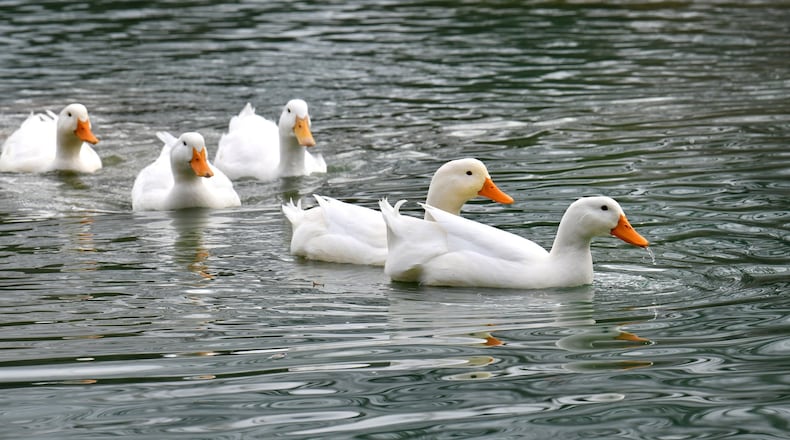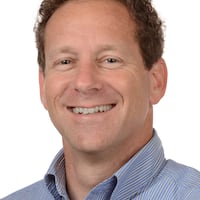If it looks like a duck and quacks like a duck, Aflac chief executive Dan Amos won’t eat it. But he will wear it.
In fact, the only ties he will bear have waterfowl images. He’s up to 63 versions of duck neckwear.
“Look, the ducks made us famous,” the 68-year-old said, “so I love them.”
Twenty years ago this month, a duck changed Amos’ business life and the trajectory of what had been an obscure Georgia company selling unusual insurance. TV commercials starring a waddling white Aflac duck gave the Columbus-based company a brand name and a persona way beyond what any business of its ilk should ever expect.
But it hasn’t solved everything.
The company founded by Amos’ father and uncles now has a stock market value of nearly $40 billion, more than triple what it was BD (Before Duck). Nine out of 10 Americans not only know the duck, but can easily — almost uncontrollably — mimic it quacking the company’s name.
The duck is literally embedded in Aflac’s trademarked name. It is emblazoned on Aflac’s headquarters tower in Columbus. And Amos recalls making just one demand when planning a satellite corporate campus a few years back: that it have a pond with ducks.
This from a company that specializes in cancer insurance, maybe the least funny thing on the face of the Earth.
Humor also has become an advertising staple for other once-somber insurers, including Progressive’s Flo, Allstate’s Mayhem, Geico’s gecko and caveman, Farmers’ hall of oddball accidents and Nationwide’s Peyton Manning and Brad Paisley shtick.
Americans continue to fret over rising health care costs. That part is good for Aflac, which specializes in supplemental insurance from accident insurance to cancer coverage.
“People are scared of out of pocket expenses,” Amos said.
Yet for all the recognition Aflac has gained from the duck and the $100 million it spends annually on advertising, 80% of Americans who know the company don’t know what it does or what it sells.
“Aflac is well known but not known well,” said Shannon Watkins, the company’s senior vice president over brand and creative services.
It’s a long-running challenge. The duck comedy got in the way of the education, Watkins said. The confusion also speaks to larger issues about how much Americans understand about insurance and its varying forms.
So, last year, Aflac marketers launched a new round of ads to try again to explain the business, with the tagline “Get help with expenses health insurance doesn’t cover.”
The duck is still in its TV spots, paired with Alabama football coach (and UGA nemesis) Nick Saban, who flashes his trove of championship rings.
“The biggest thing that changed is really the role of the duck,” Watkins said. “Over the last 20 years the duck has been the joke, and in 2019 we evolved the role of the duck to deliver the joke.”
The duck has pulled off transformations before.
The company boasts that it is the largest accident insurance provider in the U.S., where Aflac policies primarily are sold by thousands of independent contractors trying to win over employees at small and mid-sized companies. Aflac is also the biggest provider of cancer insurance and medical insurance in Japan, where 70% of company revenue is generated.
But for years, Amos struggled to get attention for the company previously known as American Family Life Assurance Company. After spending roughly $300 million on TV commercials throughout the 1990s, Aflac’s name recognition among Americans only rose from 2% to 7%.
Amos attempted to shake things up, asking for ad agencies to make their best, boldest pitches.
Ad writer Tom Amico recalled Amos saying, “I don’t care if you have to put a naked man on a roof. I just want people to remember the name of my company.”
Amico and Eric David, then colleagues at New York agency Kaplan Thaler, had developed about three solid ideas, including one that tested particularly well. It featured Ray Romano, who at the time was starring in the TV series “Everybody Loves Raymond.” With a deadline approaching, though,the creative directors struggled to come up with one final option.
Frustrated, David announced he was going to lunch, both recalled. As he walked around outside he repeated the Aflac name again and again, each time louder, as passersby gave him odd looks.
Then it struck him: that’s the sound of a duck. He told Amico, who wrote up copy for it in minutes, giving voice to a duck that sounded just as frustrated as Amos had been.
But Aflac’s CEO was uncertain when he saw an early version of the idea: two guys sitting on a park bench chatting as a duck quacked Aflac’s name.
He tried to explain the concept to Aflac’s board of directors. “They didn’t get it. There was this dead look across of peoples’ faces,” Amos remembered.
He asked a fellow CEO for advice. The reply: go with the Romano commercial.
“I was scared to death,” Amos recalled.
He opted to see if the duck would fly, committing to just a week of commercial airings.
The phone calls started rolling in. People wanted to know where they could buy the duck. In a week’s time, visits to Aflac’s website exceeded traffic for the entire year earlier.
Aflac agents in the field noticed potential customers were more open to talking. Amos greenlighted more TV time and spots.
Within three and a half years, new policy sales for Aflac had doubled. Movie star Ben Affleck talked about fans quacking his last name. The mascot eventually appeared in the Macy’s Thanksgiving Day Parades in New York and the company rolled out commercials with other famous people, including Yogi Berra.
One starred an international model who had just married a New York tycoon and was in what was described as her first major TV commercial.
“We want to give Aflac some sex appeal, that’s what the commercial is all about,” now-First Lady Melania Trump said at the time. In the spot, she was partially transformed into a duck as part of the commercial’s Frankenstein-like theme.
The duck couldn’t stay afloat at first in Japan, though. A dubbed-in translation of a U.S. commercial failed. The loud yells of the duck in the spots where off-putting. And it was considered rude that others in the commercial ignored the creature. It took two or three years before Aflac created a more subdued duck, voiced by Japanese actors and with a presence acknowledged by others in the commercial.
It worked. Insurance sales rose and Japanese consumers bought millions of plush duck toys.
Then came trouble. Comedian Gilbert Gottfried, the voice of the duck in the U.S., tweeted insensitive jokes about the earthquake and tsunami in Japan, shortly after the 2011 tragedy, triggering a potential public-relations nightmare.
Amos quickly fired Gottfried and pulled commercials. Later, he launched a widely publicized multi-city talent search for the next voice of the duck. The winner, a Minnesota radio station sales manager, has kept the gig ever since.
Amos, who is now in his 30th year as Aflac’s CEO, said he doesn’t foresee clipping the duck’s wings: “The minute you get rid of the duck, the Aflac name will drop dramatically.”
Nor, he said, has he tired of hearing people quack the company’s name at him. “I hear cha-ching.”
Which is why, though he is an active hunter, he said he doesn’t aim for duck.
Did he, before duck became so much a part of his business life?
“I don’t remember,” Amos said.
About the Author
Keep Reading
The Latest
Featured






